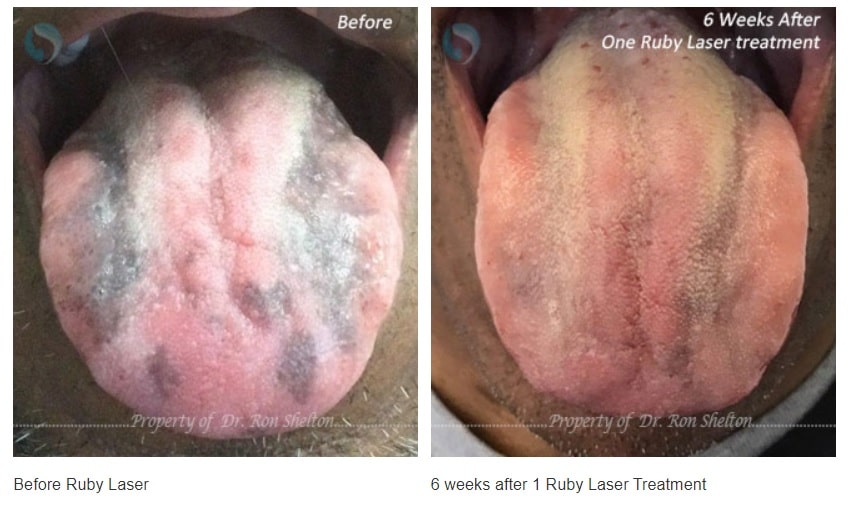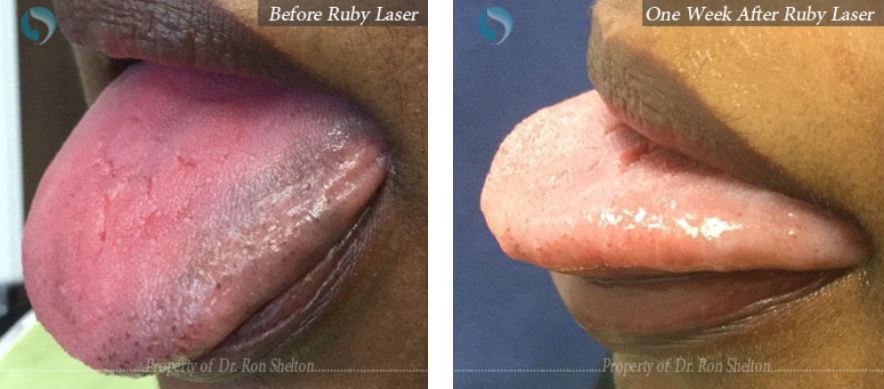Effective treatments to reduce black spots and pigmentation on the tongue
What is tongue pigmentation?
A common condition in dark-skinned individuals, tongue pigmentation is often described as Pigmented Fungiform Papillae of the Tongue. It refers to black spots on the tongue, which range from tiny dots to visible dark areas. While these spots and patches tend to be harmless (benign) and asymptomatic, some people may be self-conscious about their appearance, and these spots may contribute to a negative body image.
What are papillae?
In simple terms, papillae are tiny bumps on the tongue. Covering the surface of these papillae are thousands of taste buds.
Dr Ron Shelton refers to tongue pigmentation as Pigmented Papillae of the Tongue (PPT), as all types of taste buds can be affected as well as papillae that don’t have taste buds such as the filiform papillae.
There are four common types of papillae on the tongue:
• Fungiform (mushroom-like, mostly on the forward part of the tongue)
• Filiform (filum – threadlike, mostly on the top of the mid tongue)
• Foliate (mostly on the outer edges of the tongue)
• Circumvallate (towards the back of the top of the tongue)
1. Pigmented fungiform papillae
Shaped like fungi or mushrooms, these are commonly located on the tip of the tongue, the lateral border or the top of the tongue. Frequently appearing as a darker pink color, the visibility of these spots may vary depending on the person. Dark-skinned people seem to be more susceptible to darker pigmented fungiform papillae, but this is separate from the racial pigmentation which occurs in other areas of the tongue.
Fungiform papillae are typically a red or dark pink color. However, if they are black or dark brown, they are referred to as pigmented fungiform papillae.
2. Filiform papillae
These are threadlike projections found on the top of the tongue, usually appearing to be either pink or white. These papillae also can be dark in patients with skin of color. They are commonly found across the surface of the tongue. Filiform papillae do not have taste buds.
3. Foliate papillae
Foliate papillae resemble grooves and are located on the outer edges of the sides of the tongue.
4. Circumvallate papillae
These are large 8 to 12 mushroom-shaped bumps located at the back of the tongue, closer to the throat area.
According to Dr Shelton, a black tongue can occur in the three types of papillae mentioned above. Although dental and medical literature indicate that there is no existing cure, Dr Shelton at the Laser & Skin Surgery Center of New York has been improving PPT’s appearance for his patients since 2020, achieving good results each time.
The Ruby Laser procedure is the most frequently used laser technology available at LSSC to treat tongue pigmentation and to lighten the tone of PPT.
During the treatment, the Ruby laser uses a ruby crystal to send light pulses at one specific wavelength. These light pulses target the dark spots on the tongue. When penetrating the mucosal surface of the tongue, the Ruby laser is able to send high-intensity laser beams in short pulses to shatter the unwanted pigment without any damage to the unaffected, surrounding areas.
Refer to our detailed article here to know how Ruby laser works in depth.
In addition to the Ruby laser, Dr Shelton also uses the Picoplus laser. Picoplus is a non-surgical, non-ablative pigment laser which offers nanosecond and picosecond pulse durations. The picosecond pulse protects the tissues in the unaffected areas from thermal damage, and it successfully targets the affected area to break up pigments into easier forms for the body to process. It offers faster results and less downtime. To learn more about Picoplus and how it works, click here.
In both of the previously mentioned procedures (Ruby laser and Picoplus), most people need only a few treatments to achieve a significant reduction in color. Maintenance may be needed in the future as the pigment returns. It is conducted as an outpatient procedure in which topical anesthesia is applied to the tongue for a few minutes prior to the treatment. Most patients experience a little soreness for a day or two, but these mild aftereffects are well received and tolerated.

Ready to find out more about reducing black spots on tongue?
To determine if you’re a good candidate for laser removal of black spots on tongue and tongue pigmentation or to simply learn more about the procedure, request a consultation with Dr Ron Shelton by calling (212) 593-1818.


